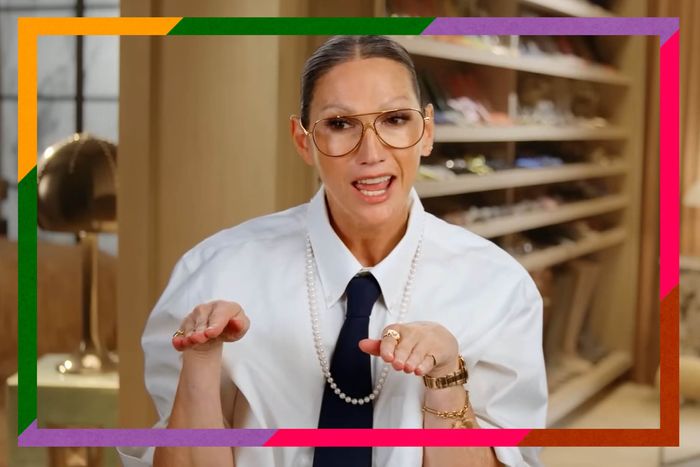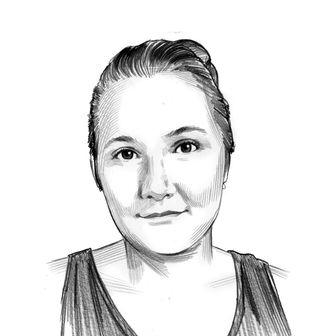
The year is 2007. I’m perched on the edge of my couch, eyes glued to the TV and thumb hovering over the remote so I can quickly change the channel if I hear my mom arriving home. She’s banned me from watching trashy dating shows, but it’s the finale of A Shot at Love With Tila Tequila, and I need to know if the MySpace star will choose Dani, a sweet, funny, sexy lesbian firefighter, or Bobby, a man with spiky hair. I don’t yet know that I’m bisexual, but I will be devastated when Tila gives her final key to Bobby. It will be disappointing, but not surprising, when, years later, Tila Tequila will admit that it was all a sham — she’s straight, she had a boyfriend while filming, and she thought the lesbians competing for her affection were “disgusting.” But it’s the mid-aughts and the only queer reality-TV starlet is a fake bisexual/actual Nazi.
Fifteen years after that frustrating evening, reality TV is in the midst of a full sapphic revolution. From Real Housewives and Selling Sunset to The Ultimatum: Queer Love and even that temple of the cult of heterosexuality, The Bachelor, lesbians and bi-/pansexual women dominated the airwaves (or, more accurately, streaming algorithms) this year. The lesbianification of reality TV was a long time coming, and we have many pioneering sisters to thank for their service. It’s worth examining how we got here.
From the ’90s through the 2000s, the best representation queer women could hope for on reality TV was a kind of gawking voyeurism. The problem wasn’t that A Shot at Love was exploitative and salacious — it was on MTV, after all — but that there were vanishingly few avenues for queer women to shine in the genre. Where straight romance could be seen as a fairy tale (on The Bachelor and other shows that were just ripping off The Bachelor) or a train wreck (on Flavor of Love et al. and, sure, also The Bachelor), and gay men found a niche on makeover shows (Queer Eye for the Straight Guy, What Not to Wear) and reality competitions (Project Runway, RuPaul’s Drag Race), women-loving women rarely got screen time.
When queer women did pop up on reality shows in the early 2000s, they were usually presented as inherently promiscuous or even predatory. Just their presence was shown to be a corrupting force. Take Kim Stolz, a contestant on America’s Next Top Model in 2005. One of the show’s first out lesbians, Stolz joked about “converting” the women she was competing against. In one scene, she declares, “One down, eleven to go” after a fellow contestant she’d been flirting with for weeks drunkenly makes out with her in a limo. It’s a relatable scene — or as relatable as that famously deranged show could get. Most queer women have at least a story or two about playing along with a straight friend’s joking flirtation. But without that context, Stolz looks at best like a pathetic sucker who can’t see she’s being taken advantage of, and at worst like a leering pervert, instead of what she actually was: a young woman psychologically tormented by Tyra Banks on a weekly basis for our entertainment, just like the rest of the contestants.
By the 2010s, we started to see more queer women on reality TV, but rarely in shows or roles that were elevated to mainstream discourse. Showtime had a modest hit with The Real L Word, billed as the reality-show version of The L Word, but it was canceled after three seasons and its legacy remains trivial in the landscape of reality history. One of my favorite reality-TV lesbians from this era was Teresa Giudice’s cousin Rosie, who appeared on a few seasons of The Real Housewives of New Jersey. Rosie was a fantastic character and would have made a great Housewife — she’s funny, sometimes sweet, prone to fits of rage, and willing to make a fool of herself on-camera — but the idea of a lesbian housewife was so antithetical to the thesis of the show at the time that Rosie was relegated to a “guest” credit (below even “Friend Of” in the franchises’s hierarchy). The show played into the same lesbian stereotypes ANTM did with Stolz, with other cast members encouraging Rosie to hit on straight women for the camera.
Elsewhere on Real Housewives, a “gay panic problem” was developing, continuing all the way through to 2020, as the Daily Beast then wrote. The Housewives had learned that a surefire way to cause damage to a rival’s reputation was to accuse her of being a secret lesbian. Entire seasons of Housewives and multiple cast departures were dedicated to lesbian panic: Denise Richards quit Beverly Hills over Brandi Glanville’s insistence that they slept together. Atlanta’s Phaedra Parks was fired in 2017 for spreading rumors that fellow ’wife Kandi Burrus was secretly gay and planned to drug their friend Porsha Williams to sexually assault her. The implication of these narratives was clear: Queer women are predatory, or at the very least untrustworthy.
In 2019, a glimmer of change appeared on the horizon. If 2023 brought reality TV’s Declaration of Lesbian Independence, MTV’s all-bisexual season of its dating show, Are You the One?, was the Lesbian Boston Tea Party. There we saw a range of queer people (or at least, a range of queer people willing to date on-camera) trying to find their perfect match. Rather than indulge in broad stereotypes, the show treated its queer cast like the straight casts before it, with sexuality as just one facet of who a person is. That year also saw Braunwyn Windham-Burke join The Real Housewives of Orange County. The mom of seven insisted she was straight but had a habit of making out with other women when drunk. The story line looked like yet another gay-panic narrative, but Braunwyn took another path, coming out as a lesbian in 2020 and daring viewers (and, more relevantly, her fellow cast members, including famously intolerant Vicki Gunvalson) to have a problem with it.
Further queering the Housewives space, Julia Lemigova, former Miss USSR and current Mrs. Martina Navratilova, joined The Real Housewives of Miami in 2021. The gayest Real Housewife we’d seen yet, Julia seemed to spend most of her time alternately bickering with and fawning over her wife, tending to her goats, and washing her enormous dogs.
Then, in 2023, came Jenna Fucking Lyons. When the former J.Crew designer was cast on the rebooted season of The Real Housewives of New York, it indicated a sea change for the franchise. An eccentric, chic, extremely gay presence, Jenna’s sexuality, rather than the subject of rumors and scandal, is presented as downright cool. It isn’t ammo for her rivals to use against her; they have to resort to slamming her for taking a private jet on a group vacation. Now, lesbian rumors are still a staple of Real Housewives, but they take on a different tenor. A major story line on this season of Beverly Hills concerns the tabloid-fueled speculation that longtime ’wife Kyle Richards is having an affair with country singer Morgan Wade. Richards’s fellow cast members do their contractually obligated digging around the subject, but the scandal is more about the state of her marriage than whether or not she’s sleeping with a woman.
In another twist featuring a reality starlet dating a queer musician, Chrishell Stause brought her non-binary partner, Australian musician G Flip, into her Selling Sunset story line this season. Again, Chrishell’s sexuality isn’t presented as scandalous or deviant. On the contrary, her relationship with G Flip is framed as a happy ending after years of emotional torment at the hands of Oppenheim Group boss Jason. Even former Bachelorette Gabby Windey is getting a happy ending with a queer relationship; she got a whole media rollout, including an appearance on The View, to hard-launch her girlfriend, alt-comedian Robby Hoffman.
But lesbians weren’t just given fairy-tale endings in 2023. Happy, fulfilled people don’t typically make for the most compelling viewing. The joys of reality television are always rooted in mess — and queer women love mess. That was best expressed on The Ultimatum: Queer Love, in which a full cast of lesbian women and non-binary folk were selected for the spinoff of Netflix’s silly dating show about couples who are given the opportunity to date other people before deciding whether to get married. The show introduced us to a group of gloriously ridiculous women dating, breaking up, starting drama, and otherwise acting a fool.
At long last, audiences and producers alike are finding out what queer women have always known: We are just as qualified as our straight counterparts — if not more so! — at stirring up complex and captivating drama. By relegating us to sidekick roles, treating who we are as inherently salacious, or platforming grifters who used bisexuality as a costume, audiences miss out on the full spectrum of WLW chaos. With the lesbian-panic story line (hopefully) in the rearview, queer women get to be the complicated, sometimes frustrating, often enviable, always messy bitches we love to see on TV.


